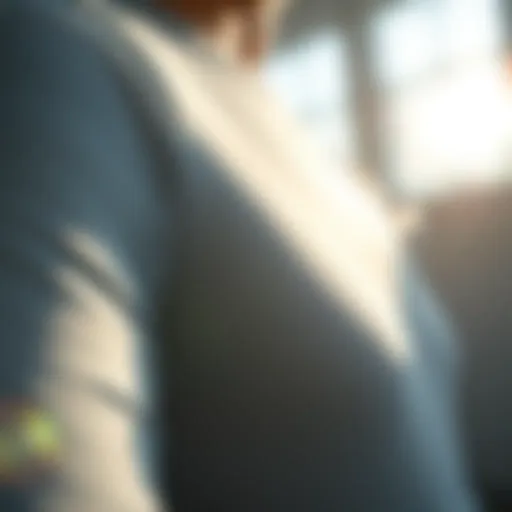Exploring Textures and Light in Fashion Design
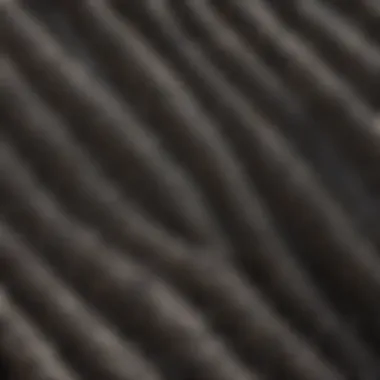

Intro
Fashion is not merely about what one dons; it’s a complex interplay of sensory experiences, telling stories through colors, fabrics, and textures. The dance of light and shade adds an extra dimension to garments, influencing how they are perceived and appreciated. Recognizing this relationship is vital for anyone looking to develop their sartorial expression.
This article shines a spotlight on the evolving narrative of texture in fashion, diving into how various materials interact with light to create depth and charisma. Picture a sleek silk blouse catching the sun, transforming hues and shadows into an art piece. This captivating dialogue between texture and illumination becomes even more crucial when navigating the various fashion trends that ebb and flow each season.
The aim is to provide a comprehensive understanding for stylists, designers, and students with discerning tastes, allowing them to harness these elements strategically. So, whether you’re crafting a runway collection or simply wanting to refine your wardrobe, the insights here will enable you to make informed, stylish choices that reflect your unique essence in every situation.
As we explore the intricacies of fashion through textures and tones, let’s journey through the current trends shaping the landscape.
Understanding the Concept of Light and Shade
Grasping the fundamentals of light and shade is crucial in the realm of fashion. These concepts shape how textiles are perceived and how they interact with the body. Light and shade serve not just functional roles but also artistic ones, enhancing the visual narrative of garments. Designers often rely on the interplay between light and fabric to create looks that either resonate or provoke. When one understands these principles, it brings a unique advantage in curating outfits that elevate personal style.
The Role of Natural Light
Natural light acts as a transformative element in fashion design. Depending on its angle and intensity, it plays tricks with textures, causing them to appear differently than they do under artificial sources. For example, a linen dress basking under the sun may exhibit a softness and fluidity that contrasts sharply with its more structured appearance in a dimly lit room. Beyond aesthetics, natural light connects observers to the world outside, often influencing mood and perception. As such, an outfit that appears flattering in daylight might fall flat indoors.
- The color palette shifts with daylight: vibrant hues may dull, while earthy tones emerge richer.
- Clothing feels different; the way a fabric drapes can change under varying light conditions, impacting how a wearer feels about their attire.
Imagine walking into a cafe with large windows at the golden hour. The light dances on your silk shirt, amplifying its sheen and drawing attention to its delicate texture. This scenario illustrates how intentional lighting can elevate the overall appeal of an outfit.
Artificial Lighting Effects
Artificial light brings its own set of influences, molding how textures are perceived. Designers often manipulate electric lighting to create specific atmospheres and draw attention to certain details in clothing. Understanding common types of artificial lighting—soft, harsh, fluorescent—helps in choosing the right attire for diverse settings.
- Soft lighting creates a dreamy effect, enhancing the romance in flowing fabrics like chiffon.
- Harsh lights, on the other hand, can amplify imperfections; while this shade can showcase the intricacies of lace, it may expose flaws in stitching as well.
Consider how a halter neck top looks under LED lights in a fashion show versus candlelight at a dinner. While the former enhances color vibrancy and fabric details, the latter inspires a more intimate and flattering ambiance. This is critical for anyone in the fashion industry—making informed decisions based on the type of lighting can vastly change the experience of the wearer and the viewer.
Psychological Impact of Light in Fashion
Light isn't just about what meets the eye; it profoundly affects our emotions and mental state. Bright, uplifting colors influenced by natural light can evoke feelings of happiness or calmness, while shadows can elicit thoughts of mystery or sophistication. The psychological dimension of lighting becomes significant when we consider the context of a particular outfit.
Wearing darker shades in subdued light may project an air of authority or seriousness. Conversely, donning bright colors in a space flooded with sunlight can signal openness and approachability. Aligning clothing choices with the emotional undertones of light can empower wearers to communicate their individual narratives effectively.
"Style is a way to say who you are without having to speak." – Rachel Zoe
In summary, understanding how light and shade interact with fashion opens doors to a deeper comprehension of garment presentation and personal expression. Natural light and artificial sources each offer different advantages and insights into the fabric's character, while their psychological implications enable a richer, more nuanced approach to styling.
Textural Elements in Clothing
In the world of fashion, the textures utilized in clothing are not just supplementary factors but are essential elements that can dictate the overall aesthetic and feel of an outfit. The interplay of various textures transforms a simple garment into a statement piece. When stylists and designers talk about textural elements in clothing, they are diving into a realm where visual and tactile experiences merge, creating a unique identity that fabric alone can't convey.
Different textures can evoke emotions or even memories, connecting wearers to certain moments or cultures. For instance, a rustic linen texture might transport one back to summer picnics, while a silky fabric can exude opulence and luxury. Fashion enthusiasts should consider how these textural elements reflect their personalities and styles. Moreover, incorporating various textures is crucial for achieving depth and dimension in ensembles.
Diverse Fabrics and Their Properties
The choice of fabric often determines the feel and functionality of a garment. Fabrics can be categorized broadly into natural and synthetic materials. Natural fabrics, such as cotton, linen, and silk, each possess unique properties that influence how they drape, breathe, and interact with light. For example, silk offers a high sheen which can produce a sophisticated look, while cotton tends to provide a more casual and comfortable vibe.
On the other hand, synthetic fabrics like polyester and nylon offer durability and easy maintenance. These materials often come with fluid textures, enabling designers to create innovative silhouettes that challenge conventional forms. Understanding the properties of these fabrics can aid in making informed decisions when it comes to crafting a wardrobe that speaks volumes without uttering a word.
The Importance of Fabric Weight
Fabric weight plays a significant role in how a garment behaves. Light fabrics, such as chiffon or georgette, are airy and float gracefully, making them perfect for layering or creating flowing silhouettes. Heavier fabrics like denim or corduroy provide structure, which can enhance a tailored look. Using differently weighted fabrics can create stunning visual interest; a lightweight top paired with a heavier bottom can balance out an outfit beautifully.
When choosing fabrics, one should also consider the season. Light fabrics are great for summer since they are breathable, while heavier ones are ideal for winter, offering warmth and insulation. Weight affects not only the garment's drape but also how it interacts with movements and poses.
Layering Techniques for Depth
Layering is an art. In fashion, it’s about more than just throwing on a jacket over a shirt. It’s a strategic approach to crafting an outfit that maintains interest from every angle. Start with a base layer, perhaps a fitted tee or a sleek dress, and then build with textures—like adding a chunky knit sweater or a structured blazer.
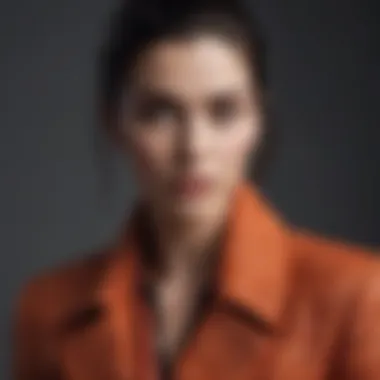

One can also play with differing lengths, where an oversized top contrasts harmoniously with a fitted bottom. This creates a visual dialogue that invites observation rather than blending in. Don't shy away from mixing textures, such as pairing a wool scarf with a satin blouse.
"Layering, when done thoughtfully, unveils a narrative within the outfit that resonates beyond fleeting trends."
In summary, mastering textural elements in clothing is pivotal for any fashion aficionado. From understanding diverse fabric properties to utilizing fabric weight and clever layering techniques, these considerations empower individuals to immerse themselves in the expressive world of fashion.
Color Theory in Fashion
Color theory plays a pivotal role in the world of fashion, acting as the backbone for countless design decisions. The hues, tones, and shades employed in fashion can evoke emotions, establish moods, and even influence perceptions. When stylists and designers grasp color theory, they unlock a treasure trove of possibilities to enhance their garments, allowing for a unique interplay of light, shade, and texture. Understanding how colors can harmonize or clash informs the selection processes that stylists utilize, ensuring the right impact is made at every turn.
Choosing the Right Palette
Selecting the right color palette is akin to choosing the paint for a blank canvas. It’s essential to consider both the season and the target audience when crafting a collection. For instance, pastel colors often resonate with spring collections, invoking thought of floral blooms and renewal, while earthy tones might speak to autumn’s warm embrace. The emotional aspect of colors should never be neglected; blue evokes calm, red brings energy, and yellow can instill a sense of happiness.
Mixing and matching can create visual interest but requires balance. Utilizing a base color, complemented by accent colors, can steer the overall theme of the outfit. Here are a few tips for making that choice:
- Consider the occasion. Is it a formal event, casual outing, or a fashion show?
- Match to skin tones. A color that looks splendid on one person might wash out another.
- Limit the palette. Sometimes, keeping it simple can make the design feel cohesive rather than chaotic.
The Interaction of Colors and Textures
When colors meet textures, it’s like a marriage that can either thrive or falter. Certain textures can enhance or mute color intensity. For instance, a matte fabric may not showcase a color’s vibrancy as effectively as a glossy option would. Furthermore, texture impacts how light interacts with colors, creating shifts in perception as garments move. This interplay allows designers to play tricks on the eye—soft silks paired with vibrant hues create a feeling of luxury, while rougher textures might ground an outfit in everyday wearability.
When considering this interaction, it’s useful to think of the rhythm of the outfit as a whole. A piece that’s matte and structured might benefit from a brighter color to enliven it, while a vibrant fabric might achieve sophistication when paired with a subtle texture.
Creating Contrast through Color
Creating contrast is not just about pairing opposing colors on the color wheel; it involves thoughtful consideration of shades, tints, and tones of each color within an ensemble. This technique brings garments to life, emphasizing unique design features. For instance, pairing a deep navy jacket with a crisp white blouse can create a classic, elegant look that draws attention without overwhelming. Likewise, using vibrant shades like magenta alongside muted tones can create statement pieces that demand attention on runways, making them memorable and striking.
“Color is the keyboard, the eye is the hammer, and the soul is the piano with many strings.” - Wassily Kandinsky
Additionally, contrast can be employed not only in color but also in texture. A sheer fabric on one part of an outfit contrasting against a structured piece can add depth and intrigue.
Historical Perspectives: Shade and Texture
The journey of fashion is deeply intertwined with texture and shade. Historically, the evolution of these elements has shaped not only how we perceive clothing but also how we express individuality and cultural identity. Understanding the historical context of shade and texture in fashion offers valuable insights into contemporary practices and enables stylists, designers, and marketers to blend tradition with modernity.
Evolution of Textile Techniques
Textile techniques have witnessed significant transformation over time. From the cozy woolen weaves of the ancient civilizations to the delicate silks of Asia, the craftsmanship behind textiles has evolved, reflecting the societies that cultivated them. The ability to manipulate fibers created a vast range of textures, influencing how garments interact with light.
- Natural Fibers: In the early days, natural fibers like cotton and linen formed the basis of clothing. The textures were often irregular yet beautifully rustic, giving garments a unique charm. These materials have the power to display light in various shades and reflections, making them timeless choices.
- Innovative Weaving: The advent of new weaving techniques led to fabrics that carry intricate patterns and textures. Techniques like jacquard weaving redefined garments, allowing for richer textures that catch light dramatically.
- Dyeing Processes: The evolution of dyeing has transformed colors from flat to multi-dimensional. Techniques like shibori or tie-dye have roots in history, yet they bring dynamic textures to modern fashion.
This evolution shows that not only have the materials changed, but so has our perception of what clothing can represent—cultural heritage, status, or even rebellion.
Iconic Fashion Movements
Fashion movements throughout history have harnessed the interplay of shade and texture in distinctive ways. Each movement, be it the opulence of the Baroque or the minimalist aesthetics of the 90s, utilized textures and shades to communicate specific sentiments.
- Victorian Era: Rich brocades and velvets were the hallmark of this period. The layering of fabrics created depth and opulence, while intricate lace details added softness, playing with light and shadow beautifully.
- Art Deco: With sharp geometric patterns and metallic textures, Art Deco harnessed modernity and luxury. The reflective qualities of these textures were designed specifically to catch the eye and illuminate elegance.
- Punk Movement: In stark contrast, the punk movement took rebellion to the next level using rough textiles like leather and distressed denim. The juxtaposition of these harsh textures with vibrant prints created a raw, dynamic aesthetic that challenged societal norms.
Each movement showcases how shades and textures not only define garments but also serve as a communication tool about societal values and individual identity.
Influence of Art on Fashion Design
Fashion has always been a canvas influenced by various forms of art. Renowned artists have used their mediums to impact fashion, bringing innovative textures and play with shades to the forefront.
"Fashion should be a form of escapism, and not a form of imprisonment." - Alexander McQueen
- Surrealism: Artists like Salvador Dalí inspired fashion designers to explore shapes and dimensions through textiles. The unusual textures and unexpected shade combinations led to garments that seemed to float away from traditional forms, embodying the dreamlike quality of the art.
- Cubism: With its fragmented forms and bold colors, Cubism gave birth to designs that embraced asymmetry and texture juxtaposition. This art movement challenged the perception of space and volume, which resonated deeply in fashion.
- Abstract Expressionism: Designers like Yves Saint Laurent took cues from the free-flowing expression of colors and textures in paint, leading to garments that celebrated individuality and personal expression.
The interplay of art and fashion continues to inspire designers today. By reflecting on historical influences, we gain clarity on how light, shade, and texture have evolved together, transitioning from mere fabric choices to vital components of personal expression.
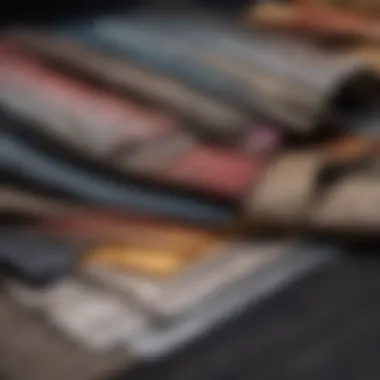

As the conversation around shade and texture in fashion progresses, it's essential to remain aware of their historical significance—acknowledging what has come before can guide how we craft the future of fashion.
Contemporary Trends in Texture and Shade
In today’s fashion landscape, the interplay between texture and shade has transformed. It’s not just about choosing what looks good but building layers of meaning, resonance, and sustainability. Designers and consumers alike find themselves drawn to the tactile and visual dimensions of clothing. Texture influences not only the aesthetic but also the emotional impact a piece can have. For folks in the fashion industry, understanding these trends can be vital for creating and marketing appealing collections that resonate with a discerning audience.
Sustainable Practices in Fashion Textures
The conversation around sustainability has migrated onto the design floor, leading various fashion houses to innovate in how they produce textures. Choices are often driven by a desire to lessen the environmental footprint. Brands like Stella McCartney adopt eco-friendly materials like organic cotton and recycled polyester in their textiles. The focus now is also on upcycling; taking discarded garments and transforming them into something fresh and functional.
- Benefits of Sustainable Textiles:
- Helps save water and reduce pollution during production.
- Supports ethical labor practices by ensuring fair wages.
- Attracts a conscious consumer base.
By opting for sustainable practices, designers can intertwine their art with a purpose, appealing to individuals who value not just the beauty of fashion but its impact on the world.
Innovative Materials and Their Impact
Innovation is sparking a revolution in fashion textiles. Think beyond the traditional. Materials like faux fur, vegan leather, and even banana fibers are making their presence felt, changing the way we perceive and experience fashion. These alternatives are exceptionally versatile; they can adapt to different styles, seasons, and moods.
For instance,
"Faux fur, once dismissed as merely a substitute, now has a place on runway and street alike, showcasing how texture can evoke luxury without a price on ethics."
Key impacts of utilizing innovative materials include:
- Diversity of Textures: With new materials come new textures, enhancing the visual depth of outfits.
- Market Appeal: Attracts a wider audience, especially those interested in cruelty-free alternatives.
- Functional Performance: Many of these materials offer unique properties such as moisture-wicking and breathability, which enhance wearability.
Runway Trends Emphasizing Light and Shade
Fashion weeks across the globe now actively feature collections that bring light and shade into the forefront of design. From liquid-like satin reflecting the slightest glint to textural layering that creates shadows, these elements engage the eye and stimulate conversation.
Designers like Ann Demeulemeester and Issey Miyake emphasize the dance of light and shade. Their collections often explore contrasts—matte meets glossy, heavy flows with airy textures—commanding attention and challenging traditional norms.
Here are some emerging runway trends:
- Monochromatic Layers: Utilizing multiple shades of a single color to create depth.
- Mixed Fabrics: Combining contrasting textures for a multi-dimensional effect.
- Shadow Play: Strategic cut-outs and sheerness that engage with light in variable ways, contorting perceptions of silhouette and form.
In essence, the contemporary landscape of texture and shade in fashion isn’t merely a trend; it’s a movement towards a richer, more meaningful dialogue in personal expression.
Practical Application: Styling with Shade
The realm of fashion is more than just draping fabric. It's about weaving personal stories through choices that reflect one's identity. The art of styling with shade delves into how light and texture interplay in our outfits, acting as a canvas that speaks volumes. This section isn't merely an academic discourse; it serves as a practical guide for stylists, designers, marketers, and even students eager to harness the aesthetic potential that light and shade offer.
Understanding shade allows one to emphasize certain features of clothing while minimizing others, leading to a strategic enhancement of the visual narrative. Practical applications in styling with shade can drastically alter garment perception, influencing everything from silhouette to texture. The layering of different fabrics can create striking visual contrasts, and understanding how these elements work together can be the difference between a forgettable outfit and one that stands out.
Moreover, considering seasonal light shifts gives extra nuance to fabric choice and color combinations, allowing for a seasonal dialogue through fashion.
Combining Layers for Visual Interest
Layering isn't just about putting one piece atop another; it’s a method to infuse life into a look. When skillfully executed, layering creates a beautiful rhythm that invites the eye to explore the design. Visual interest is achieved through texture and shade, with different materials complementing or contrasting against one another.
- Choose various textures: Mix heavy knits with light silks or denim. This contrast can create a sense of depth.
- Use sheer layers: Adding a gauzy layer can transform a structured outfit into something ethereal.
- Vary lengths: Always consider the lengths of each layered garment. Longer pieces can add flow and dynamism, whereas shorter items can accentuate the waist.
When layering, consider how each element interacts with light. For instance, a satin piece catching the evening light contrasted with a matte wool can create stunning visuals that change as your movement does.
Accent Pieces that Create Depth
Accent pieces are the silent heroes of any outfit, often adding a layer of intrigue that elevates an ensemble from ordinary to extraordinary. A well-chosen accent can create depth, acting like a cherry on top that succeeds in bringing together various textures and shades.
- Belts and Sashes: These can act as anchors in your outfit, subtly guiding the viewer's gaze. A thick leather belt over a flowing dress, for instance, enhances the waist while adding texture contrast.
- Statement Jewelry: Large earrings or chunky necklaces add an unexpected twist and can reflect light in unique ways, enhancing the overall theme of an outfit.
- Scarves and Wraps: These can be draped or tied, allowing for fluidity in color and texture without overwhelming the look.
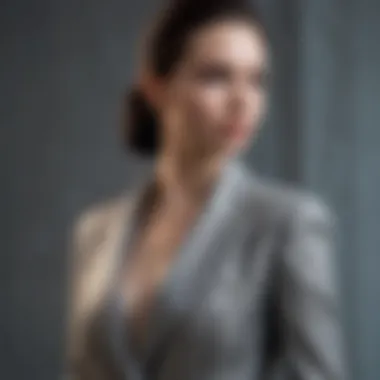

Remember, it's all about balance. The accent should draw attention but not overshadow the main elements. An effective accent piece works symbiotically within the whole outfit.
Color Combinations for Transitional Seasons
Transitional seasons offer a unique opportunity for creativity in fashion. As the weather shifts, so do the colors and textures we choose. Styling with shade can help create a harmonious flow between two very different weather patterns.
- Earthy tones: Muted shades of brown, green, and rust are perfect for autumn. These colors play well together and can be layered effectively.
- Pastels: Spring is about soft colors. Combining a pastel top with neutral bottoms provides a light yet put-together look.
- Juxtapositions: Pairing a bold color with a more subdued hue can create a striking visual impact. For example, a vivid teal with beige creates an eye-catching equilibrium.
Embracing the dynamic nature of transitioning seasons not only affects fabric choices but also how those fabrics interact with light, leading to a modern yet timeless aesthetic.
"Fashion is not just about clothes, it's about statement, identity, and the interplay of light and texture that shares your story with the world."
By utilizing these practical applications, one can become adept at styling with shade, turning routine outfits into thoughtful expressions of personal style.
Case Studies: Iconic Fashion Figures
The examination of iconic fashion figures offers invaluable insights into the interplay between texture, light, and shade within fashion. These individuals don’t merely wear clothes; they craft a narrative through their choices, demonstrating how fabric and design can resonate with personal expression and broader cultural comments. By analyzing their stylistic choices, we can deconstruct the elements that make their looks memorable and impactful, transforming technical details into inspiring principles applicable across different fashion contexts.
Analysis of Key Styles
Iconic fashion figures like Coco Chanel or Alexander McQueen serve as touchstones in understanding how textured garments and light interplay create signature styles. Chanel, for instance, famously championed simplicity blended with luxury - think of her tweed jackets, which paired distinct textures with understated elegance. On the other hand, McQueen often leaned on dramatic contrasts, utilizing darker shades against intricate fabrics to evoke emotion and challenge societal norms.
By dissecting these key styles, one can see how texture adds depth, guiding the viewer's gaze and influencing emotional responses. When analyzing these figures, one can consider:
- The fabric choices they made, understanding how materials like silk or denim interact with light and create a silhouette.
- Their use of layering techniques, which added dimensionality to outfits.
- The color choices that complemented textures and responded to lighting conditions, creating a dynamic viewing experience.
Influence on Modern Fashion Practices
Many current trends in fashion stem from the work of these iconic figures, directly affecting how contemporary designers approach texture and shade today. Modern clothing often borrows elements from these historical references to elevate collections. For instance, the resurrection of vintage-inspired styles often takes cues from Chanel's minimalist designs or McQueen's bold, theatrical garments.
Moreover, as fashion becomes more inclusive, designers like Rihanna or Virgil Abloh echo the principles laid down by their predecessors. They harness the concept of texture to build collections that resonate with diverse audiences since they appreciate how clothing can reflect personal identity or cultural connections. The lesson from fashion icons is that:
- Textures can be unified across different trends and styles, bridging past and present.
- Attention needs to be paid to how light and shades affect perceptions, leading this to be an essential topic in modern discussions on sustainability and ethical fashion.
Cultural Significance of Their Choices
The choices made by these fashion icons are often steeped in cultural significance, reflecting broader societal themes. For instance, consider how the vibrant patterns and textures of African textiles, embraced by figures like Dapper Dan, are not just about aesthetics; they serve as a powerful commentary on identity and reclaiming cultural narratives.
In contrast, the monochromatic palette often favored by designers in high fashion critiques the fast-paced world of consumerism, a theme deeply rooted in modern culture that aims to evoke thought around sustainability.
This cultural relevance further enhances the depth of their choices:
- Identity through fabric: How personal and cultural identity manifests in clothing choices.
- Social commentary: Using fashion as a means to challenge or comment on norms, with texture and light forming part of the dialogue.
Fashion is not just what you wear; it’s a language of identity, culture, and personal expression. By dissecting the choices of these icons, we uncover layers of meaning that transcend individual garments.
Epilogue: The Lasting Impact of Light and Shade
As we wrap up this journey through the intricate interplay of light, shade, and texture in fashion, it becomes abundantly clear that these elements occupy a pivotal role in defining personal style. Fashion isn’t merely about garments; it’s about how these garments resonate with light, create shadows, and interplay with textures. This relationship profoundly affects viewer perception and influences how we communicate our identity through fabric choices.
Personal Expression through Fabric Choices
When it comes to fashion, the fabrics we choose are like canvases that allow us to paint our identities. Each material brings its own narrative—silks whisper elegance, while denim shouts comfort and ruggedness. This offers a potent avenue for personal expression.
- Textures as a Voice: Textures do more than cover our bodies; they speak volumes about who we are. A person who frequently wears vibrant patterned fabrics may express an extroverted personality, while someone gravitating towards muted, soft materials might convey calmness and introspection.
- Layering for Storytelling: Layering different materials not only adds depth but also complexity to one's style narrative. Consider pairing a sleek leather jacket with a flowing chiffon dress. The juxtaposition of hard and soft textures can symbolize the balance (or tension) between strength and vulnerability.
- Cultural Influences: Fabric choices can also echo cultural backgrounds, infusing a sense of heritage into modern fashion. For instance, adopting traditional textile patterns and materials can create a bridge between personal identity and global cultures.
Fashion, at its core, is an art form that thrives on individuality. Through thoughtful fabric selection, each person has the potential to tell their own story, layer by layer.
Future Directions in Fashion Textures
The landscape of fashion is always shifting, often influenced by technology, societal trends, and environmental considerations. Here are some promising directions in which fabric textures are moving:
- Sustainable Textiles: As awareness of environmental issues heightens, we see an increasing shift toward sustainable practices in the production of textiles. From organic cotton to recycled materials, these fabrics not only offer unique textures but also align with a growing demand for eco-friendly fashion choices.
- Tech-Enhanced Fabrics: The integration of technology into textiles is creating a new frontier. Fabrics that can change color with temperature or light can give wearers the ultimate command over their aesthetic. Imagine stepping into a room, and your dress adapts to the ambience, making you the focal point.
- Inclusivity in Fashion: The movement towards inclusivity is pushing designers to explore a wider range of textures and materials to accommodate various bodies and styles. This shift emphasizes personal expression and creates options that resonate across diverse audiences.
"In fashion, it's more than the look—it's about the feeling, the texture, and how they interact with light to create beauty."
As we continue this dialogue on texture and light, remember to let your choices reflect who you truly are.







